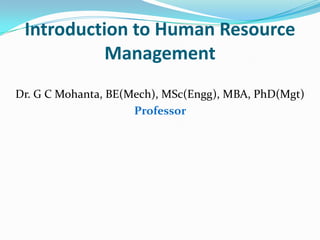
Human resorce management ppt
- 1. Introduction to Human Resource Management Dr. G C Mohanta, BE(Mech), MSc(Engg), MBA, PhD(Mgt) Professor
- 2. Human Resources HR is the total knowledge, skills, creative abilities, talents and aptitudes of an organisation’s workforce as well as the values, attitudes and beliefs of the individuals involved
- 3. What is Human Resource Management (HRM)? Human resource management is the effective use of human resources in order to enhance organizational performance HRM is the art of procuring, developing and maintaining competent workforce to achieve goals of an organisation in an effective and efficient manner
- 4. Evolution of HRM Concept Labour / Manpower – denotes physical abilities & capacities of employees – commodity - wages based on demand & supply Personnel – persons employed in service – employees as a whole HR- denotes resources of all the people who contribute their services to the attainment of organisational goals
- 5. Evolution of HRM in India Welfare (1920s-1930s) Administration (1930s- 1940s) Employee relations (1940-1960s) Functional expertise (1970s-1980s) Business partner / player (1990s)
- 6. Importance of HRM HR – most important resource Put other resources to proper use Help transform lifeless factors of production into useful products Capable of enlargement – produce extraordinary things when inspired Can help organisation achieve results quickly, efficiently & effectively
- 7. Objectives of HRM Maximize the return on investment from the organization's human capital and minimize financial risk To align the capabilities and behaviors of employees with the short-term and long-term goals of the organisation
- 8. Objectives of HRM Societal objectives To be ethically & socially responsible to the needs of the society while minimizing the negative impact of such demands upon the organization Organizational objectives To recognize the role of HRM in bringing about organizational effectiveness Functional objectives To maintain the department’s contribution at a level appropriate to the organization’s needs Personal objectives To assist employees in achieving their personal goals in a manner that their personal goals enhance the individual’s contribution to the organization
- 9. Scope of HRM Prospects Nature of of HRM HRM Very vast Covers all major activities in the Industrial Relations Employee working life of a HRM Hiring worker - from time an individual enters into an Employee Employee organization until & Maintenance Executive he or she leaves, Remunera Employee tion comes under the Motivation purview of HRM
- 10. Human Resource Management Functions
- 11. Recruitment
- 12. Recruitment The process by which a job vacancy is identified and potential employees are notified The nature of the recruitment process is regulated and subject to employment law Main forms of recruitment: through advertising in newspapers, magazines, trade papers and internal vacancy lists, company websites
- 13. Recruitment Job description – outline of the role of the job holder Person specification – outline of the skills and qualities required of the post holder Applicants may demonstrate their suitability through application form, letter or curriculum vitae (CV)
- 14. Selection
- 15. Selection The process of assessing candidates and appointing a post holder Applicants short listed – most suitable candidates selected Selection process – varies according to organisation
- 16. Selection Interview – most common method Psychometric testing – assessing the personality of the applicants – will they fit in? Aptitude testing – assessing the skills of applicants In-tray exercise – activity based around what the applicant will be doing, e.g. writing a letter to a disgruntled customer Presentation – looking for different skills as well as the ideas of the candidate
- 18. Discipline
- 19. Discipline Firms cannot just ‘sack’ workers Wide range of procedures and steps in dealing with workplace conflict Informal meetings Formal meetings Verbal warnings Written warnings Grievance procedures Working with external agencies
- 20. Development
- 21. Development Developing the employee can be regarded as investing in a valuable asset A source of motivation A source of helping the employee fulfil potential
- 22. Training
- 23. Training Similar to development: Provides new skills for the employee Keeps the employee up to date with changes in the field Aims to improve efficiency Can be external or ‘in-house’
- 24. Rewards Systems
- 25. Rewards Systems The system of pay and benefits used by the firm to reward workers Money not the only method Fringe benefits Flexibility at work Holidays, etc.
- 26. Trade Unions
- 27. Trade Unions Importance of building relationships with employee representatives Role of Trade Unions has changed Importance of consultation and negotiation and working with trade unions Contributes to smooth change management and leadership
- 28. Productivity
- 29. Productivity Measuring performance: How to value the workers contribution Difficulty in measuring some types of output especially in the service industry Appraisal Meant to be non-judgmental Involves the worker and a nominated appraiser Agreeing strengths, weaknesses and ways forward to help both employee and organisation
- 30. Motivation Motivating employees to perform up to their potential is the key to maintaining a productive, successful business Ways in which you can motivate employees – Interact - Talk to your employees regularly Recognition & Appreciation - A job well done should be appreciated and encouraged Pay them Right - Pay employees for what they are worth and they will be happy to work. New challenges - Give employees new and interesting challenges to keep them stimulated and learning